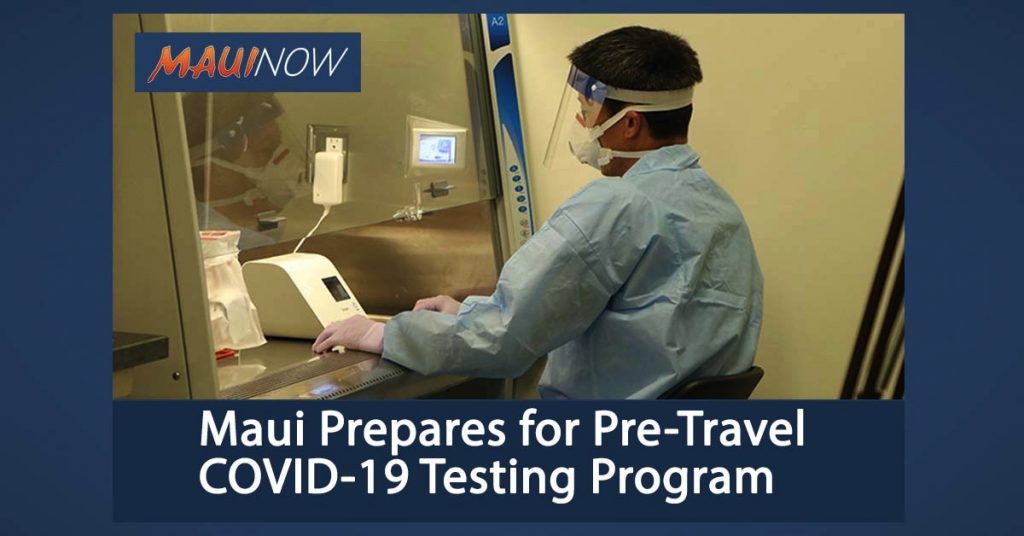Maui Prepares for Pre-Travel COVID-19 Testing Program
By Wendy Osher
Governor David Ige on Wednesday announced a new pre-travel testing program for transpacific travelers starting Aug. 1. Travelers who receive a valid negative PCR diagnostic test, 72 hours prior to their trip to Hawaiʻi, will not be subject to the 14-day mandatory quarantine. Travelers who do not obtain a negative test, will still be subject to the quarantine. Full details are available here.
County officials say the Governor’s announcement gives the visitor industry and businesses time to implement proper health and safety measures.
“For me I am at that point where I hear the world saying we need to open up–which is our unemployed and our visitor industry. But all the other ancillary services–restaurants and other retail outlets that have some dependency on our visitor–they’re also hurting,” said Mayor Victorino.
County officials say that while the state moves forward with reopening Hawaiʻi to transpacific travelers, it’s important to review how far the County has come since the original stay-at-home order went into place.
The county is currently working with the Airport Division to implement changes at Kahului Airport Operations to ensure protocols are in place before the Aug. 1 deadline.
Assessing Critical Capacity
Critical capacity and testing capability were among the key factors considered when determining the timeline for resumption of travel.
In Maui County, more than 9,700 tests have been conducted, with nearly 99% returning negative. This includes 11 new cases over the past 60 days.
Johns Hopkins University & Medicine ranks Hawaiʻi near the top in states that meet testing positivity recommendations, with 1.1% positive tests (based on a 7-day moving average). County Managing Director Sandy Baz said this means it appears the state “is testing enough of its population to make informed decisions about reopening.”
Maui County and the rest of the state has increased its contact tracing capacity and continues to train more tracers through the University of Hawaiʻi, including UH Maui College.
Additional key factors are the availability of ICU beds, ventilators and PPE supplies. In Maui County, less than half of the ICU Beds are in use, and an estimated 21% of ventilators are in use. There are currently no ICU Beds or ventilators being used for COVID patients in Maui County. County officials say there continues to be an adequate supply of PPE with more on order.
Maui has recorded a total of six COVID-19 related deaths since the pandemic started. The county reports that there have been no additional deaths in Maui County since May 3. “We extended our deepest condolences to our families who have lost loved ones due to COVID-19, and continue to ask our community to surround them with love and support,” said Baz.
Improved System Protocols
County officials say they have improved system protocols at elder care facilities, airports, transit operations and workplaces.
“They have managed visiting expectations and provided robust testing and safe quarantine space,” said Baz of elder care facilities.
Meantime, airports have instituted temperature checks, travel forms and new procedures for travelers. This transition was made when the interisland travel quarantine was lifted last week on Tuesday, June 16, 2020.
Transit operators require cleaning and sanitizing of high-touch points, wearing of facial coverings and provide hand sanitizer; and many workplaces are doing temperature checks, wellness assessments and are requiring the use of face masks.
“This is the new social norm and a great majority of residents are wearing masks when out in the public. We have adjusted our greetings with others to have less physical contact, and many of us are staying home when feeling sick, rather than putting others at risk. Businesses and students have adapted to doing more telework, virtual learning and digital meetings,” said Baz.
Better Virus Information
Although there are still many questions surrounding COVID-19, County officials say they have learned a lot more about the virus since it first came to Hawaiʻi.
“We understand that the virus is being transmitted before people are symptomatic, with 60–80% of transmission happening at a pre-symptomatic state,” said Baz, pointing towards information compiled by the Harvard T.H. Chan School of Public Health.
“The primary transmission of the virus is airborne so it’s important for everyone to always wear a mask when possible,” he said.
“Super spreading–where one person infects a lot of people is one of the biggest risks, but we can help to prevent this by socializing in smaller groups outdoors,” said Baz, highlighting the County’s rules that limit the gathering to groups of 10 or less–with no more than 50 indoors and 100 outdoors.
“The best prevention for the virus is to have each of us be proactive with these new protocols from the Centers for Disease Control and Prevention, our state Department of Health and our County of Maui Rules,” said Baz.
The threshold identified by the state for when it would look towards closures again to help control the virus is if cases doublers within two incubation periods. “An incubation period is about two weeks, so we’re looking at if cases double basically four weeks in a row, then they would be looking at closing things back down again,” said Baz.










